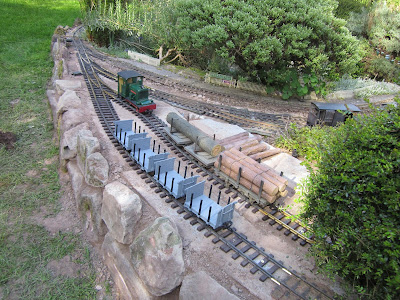Since 2009, this siding has proved adequate, but over the years, more timber wagons have been acquired and recently, another four were added to the stock roster.
The single siding at Peckforton was now no longer capable of holding all the rolling stock which might need to be accommodated. I therefore decided an extension was needed. A quick survey of the area led to the conclusion that the station area could easily be widened and a second siding added.
Pointwork was roughly laid out over the intended area which was then marked out (with some of the plastic logs from the timber yard). In effect, the concave curve of sandstone walling would need to be made convex.
A trench was dug along the line of the new wall. As it would not be bearing a great load, I made it the width and depth of the spade blade.
The affected track was lifted and the old sandstone retaining wall was removed. It proved more substantial than I expected and the dainty hammer and chisel which I had used to start the job made way for a sledge hammer and pick-axe - very therapeutic! Most of the sandstone blocks were rescued, but some of the smaller bits, plus some of the old concrete, were used as rubble to line the bottom of the trench.
This was pulverised with a lump hammer to provide a firm foundation.
A 3:1:1 mix of sand, gravel and cement was mixed, poured into the trench and then tamped and smoothed off with an offcut of timber.
While the concrete was still wet ........
.... the bottom row of sandstone blocks was embedded into it, thus ensuring a firm foundation. This was left overnight and the following morning to allow the concrete to harden off.
Topsoil was then back-filled behind the blocks and trodden down to a level about the depth of a breeze block below the original trackbed.
A breeze block was then positioned on the new section and levelled, using a spirit level, with a mix of sand and soil.
Once a datum level had been established, a couple of blocks were laid to support the passing loop ......
....... before another four blocks were laid for the new siding.
The track was laid temporarily to check the alignments. I decided some adjustment was needed and so the original point leading into the passing loop was moved further back by about 20cm.
A further two and a half blocks were then laid alongside the four to support a second siding. The second row of sandstone blocks was then concreted on top of the first row to bring the walling up to the level of the blocks. Concrete (a 4:1 mix of sand and cement) was also forced in between the blocks to help prevent weed growth and the bind the blocks together. I used my fingers (clad in heavy duty rubber gloves) for this as I've not yet found a tool which will beat their dexterity at this task. And besides, it's much more fun.
The concrete was then left to harden overnight. The following morning, while the concrete was still in its 'green' state, a wire brush was used to tidy up the face of the sandstone walling, removing any concrete which had strayed on to the rocks' surfaces.
Once the concrete had set sufficiently (it could probably have done with another day to dry off - but rain was forecast), I started laying the track. 3mm dia. holes were drilled in the sleepers and a 6mm dia masonry bit was used to drill holes into the breeze blocks to take rawlplugs.
The track was screwed down to the blocks with 1¼" No.6 brass screws.
The geometry of the passing loop and the goods siding needed to be 'tweaked' slightly to enable them to be aligned with the new pointwork. At the same time, the distance between the tracks at the end of the loop nearest the camera was widened as, in the past, this has proved to be too tight for some rolling stock.
Once all the track had been laid and fixed into place........
..... it was tested.
More extensive testing needs to be done with a wider range of rolling stock and all locos to ensure there are no unexpected snags (once the weather improves), and then the whole station area will be ballasted using my combination of wet-mix and dry-mix ballasting techniques (see How I ballasted the station area at Beeston Market).
Overall, the extension took four days - including the concrete drying times. Fortunately, I beat the weather which has included heavy rain showers every day since the extension was complete.
I have now created sufficient space alongside the sidings for a representation of a sawmill to be constructed. In my imagined history for the railway, the forestry which was created by Lord Tollemache on the Peckforton Estate was extended to become a flourishing industry providing pit props and finished timber. Felled lumber would also be brought to the mill from the surrounding area - by rail of course.









































